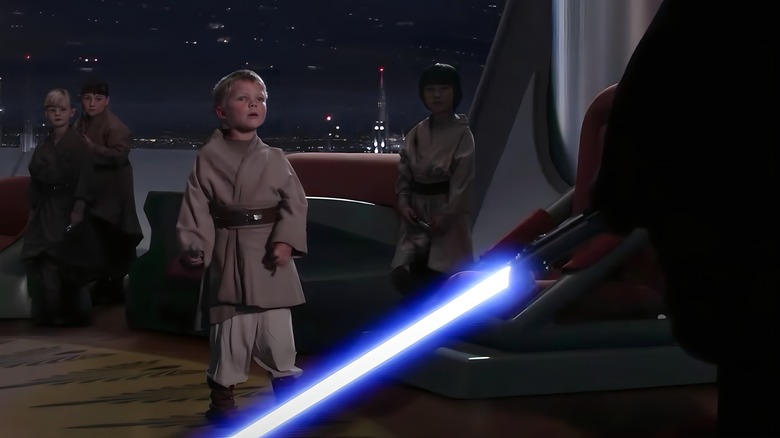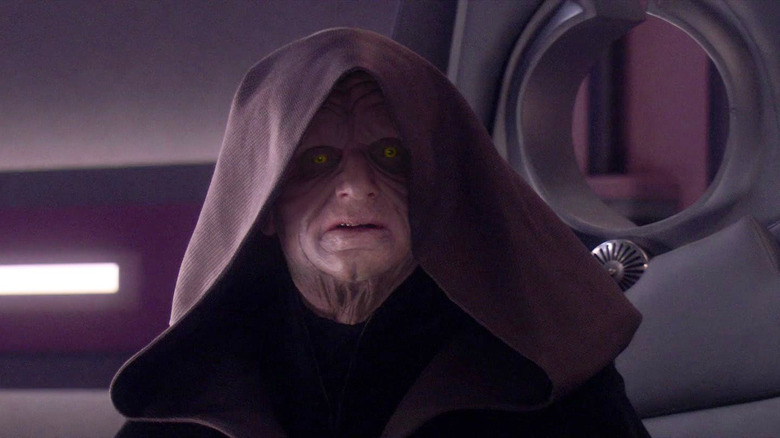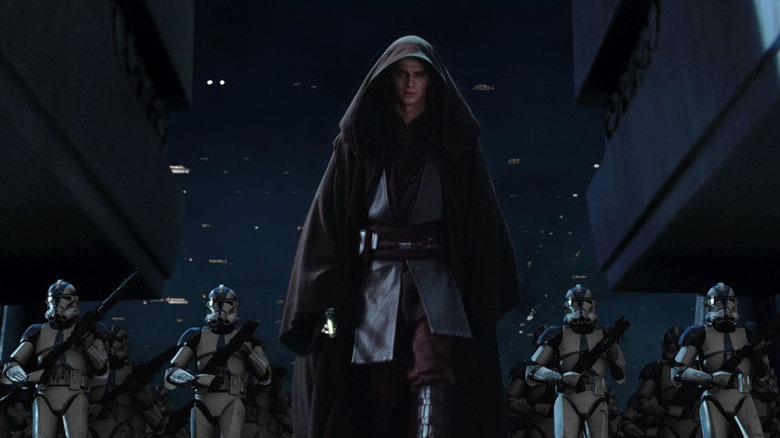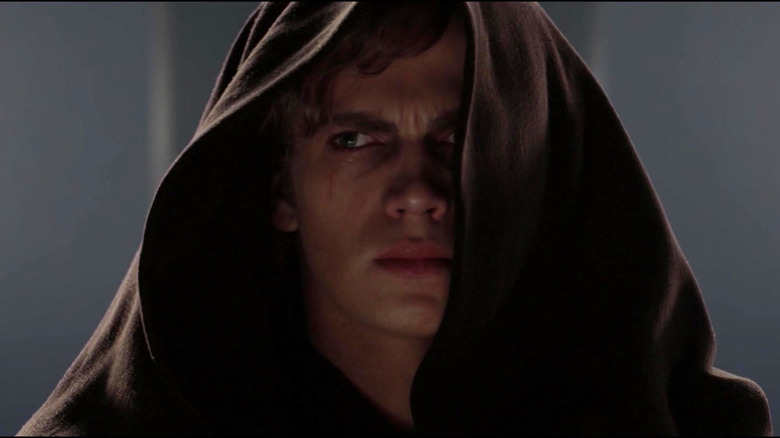Why Anakin Killed The Younglings In Star Wars: Revenge Of The Sith
Anakin Skywalker murdering Younglings in George Lucas's "Star Wars: Episode III — Revenge of the Sith" might be both one of the most brutal and darkly ridiculous "Star Wars" moments ever ... from a certain point of view. ("All too easy," as Darth Vader once put it.)
Upon arriving at the eleventh hour to assist Darth Sidious/Palpatine in defeating Mace Windu (sending Samuel L. Jackson's purple lightsaber-wielding Jedi out like the badass he is), Anakin pledges his loyalty to the Sith lord. Our "Chosen One" then proceeds to march an army of Clone Troopers over to the Jedi Temple on Coruscant. Not long after, we cut to Anakin cornering a group of Younglings in the Jedi Council's chambers. Cue Anakin extending his lightsaber as he prepares to mow down a room of wide-eyed and terrified children.
In context, of course, this scene is extremely effective in showing just how far gone Anakin is from that young man who once cried after killing a bunch of Tusken Raiders for kidnapping his mother and letting her die. (Not that this was, in any way, a justified course of action.) Whatever part of him was still capable of feeling remorse has been banished to the deepest recesses of his mind. Once you've crossed the line into executing children on your boss' orders, you've truly committed yourself to the whole bad guy thing.
What makes this moment borderline comical is that, right before it happens, we see Clone Troopers battling fully-grown Jedi in an intense firefight spread throughout the Temple. Is the implication that Anakin beelined for the closest potential Younglings hiding spot, leaving the clones to do all the heavy lifting? And why bother killing a bunch of kids barely strong enough to pick up a lightsaber in the first place? The film doesn't really offer an explanation, but we may find the answers elsewhere.
Look to the sacred texts
"Star Wars" movie novelizations have always been an invaluable resource for anyone seeking greater insight into the films' plots and the motivations of their characters. Sure, we can quibble over whether they're strictly canonical or not, but the general rule of thumb is that as long as they don't directly contradict anything in the movies, they're fair game.
In the case of "Revenge of the Sith," there's a key difference between what Palpatine tells Anakin after dubbing him Darth Vader in the film and what he says to Anakin in the official novelization by Matthew Stover. In the movie, Palpatine states:
"The Jedi are relentless. If they are not all destroyed it will be civil war without end. First, I want you to go to the Jedi Temple. We will catch them off-balance. Do what must be done, Lord Vader. Do not hesitate. Show no mercy. Only then will you be strong enough with the dark side to save Padmé."
In Stover's novel, however, Palpatine's command leaves even less wiggle room when it comes to his full meaning:
"The Jedi are relentless. If they are not destroyed to the last being, there will be civil war without end. To sterilize the Jedi Temple will be your first task. Do what must be done, Lord Vader. Do not hesitate. Show no mercy. Leave no living creature behind. Only then will you be strong enough with the dark side to save Padmé."
Terms like "sterilize" directly evoke the fascist regime of Nazi Germany and the Holocaust. Moreover, Palpatine demanding that Anakin "leave no living creature behind" makes it horribly clear: the Sith lord was calling for nothing less than the complete and utter eradication of the Jedi Order and its members, regardless of their age or training.
Revisiting Order 66
One of the best things about the "Star Wars" television series are their capacity to do things the prequel films never could, like depicting paradigm-shifting events through the eyes of different characters. In "The Mandalorian," we see Order 66 from Din Grogu's perspective (yes, we're using his new name now, get used to it), revealing how he escaped Anakin's assault on the Jedi Temple. The "Obi-Wan Kenobi" series further reveals that Inquisitor Reva was once a Youngling who survived the Temple attack, making her one of the few individuals aware that Anakin and Vader are the same person.
Those "Obi-Wan Kenobi" flashbacks to Order 66 also serve the purpose of clarifying that yes, Anakin fought side-by-side with the clones as they steamrolled through the Temple on his way to the Jedi Council's chambers. The "Revenge of the Sith" novelization makes it equally explicit that Anakin killed many of the Temple's Jedi himself, starting with the Gate Master Jurokk. A description of their encounter reads as follows:
"Anakin," he said slowly, "what's going on? Something's happened. Something horrible. How bad is it—?"
The last thing Jurokk felt was the emitter of a lightsaber against the soft flesh beneath his jaw; the last thing he heard, as blue plasma chewed upward through his head and burst from the top of his skull and burned away his life, was Anakin Skywalker's melancholy reply.
"You have no idea ..."
Obviously, we're meant to intuit what Anakin does prior to the infamous Younglings scene in "Revenge of the Sith." Still, as this passage illustrates, simply showing the start of Anakin's murderous rampage makes his eventual killing of the Younglings impactful in a way that the movie, with its curious editing of the events leading up to this moment, does not.
The downfall of Anakin Skywalker
Nobody goes from a cheerful kid who loves podracing to committing genocide overnight, and Anakin Skywalker is no different. The "Star Wars" prequels, however, skip over a lot of important steps while charting Anakin's downfall, leaving it once again to their novelizations and the "Star Wars" TV shows to fill in the blanks.
The animated "Clone Wars" series, in particular, goes a long way in showing how Anakin earned his reputation as a cunning warrior. At the same time, it uses a far subtler hand than the prequels when it comes to exploring the darkness looming beneath his noble exterior. There may be no better example of this than in the episode where Anakin ends a standoff between Obi-Wan, the Mandalorian Duchess Satine Kryze, and the treacherous Kalevalan prince Tal Merrik by sneaking up and stabbing Tal in the back:
The way Anakin casually shrugs off his actions ("What? He was gonna blow up the ship."), combined with composer Kevin Kiner integrating a few notes from Darth Vader's iconic theme, foreshadows the slippery slope Anakin was on well before he started butchering children. It certainly applies a much finer touch than his meme-spawning, "Actually, I'm kind of cool with dictatorships" comments from "Attack of the Clones."
That's not to suggest the prequels are devoid of understated storytelling. Arguably the best moment in "Revenge of the Sith" — and maybe even the entire prequel trilogy — is the scene where Anakin silently contemplates whether or not to align himself with Palpatine. But for the most part, those movies tend to favor something of a sledgehammer approach. And nothing gets your point across quite like showing your story's supposed hero (reluctantly but willingly) pulling out their weapon to massacre a bunch of kids.



